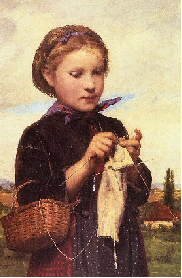Tips before you buy a spinning wheel
Editor’s Note: You should be basically familiar with the parts of a spinning wheel. If not, please Open this window which will show you a diagram of a spinning wheel for reference. Open a diagram of the spinning wheel
We will begin by looking at the heart of the machine, the flyer mechanism.
Start the flyer inspection by disconnecting the drive band. With the flyer
mounted in the maiden bearings, give the flyer a twirl and see how freely it rotates.
(You may need to turn the maidens a bit to position the bearings a little better).
Next remove the whorl from the flyer shaft. Most double drive flyers are left hand thread (opposite from a normal bolt thread) although I’ve noticed some mass
produce manufacturers use a right hand threaded whorl. Be careful not to use extreme force if you are not sure which way the thread comes off. It should
be snug but if it appears it won’t come off, try the other direction.
With the whorl removed, slip off the bobbin and take a look at the flyer shaft.
There should be no burrs or large machining marks visible.
Check the end that rides in the rear maiden bearing. Is the surface very smooth?
Polished? It should be very smooth with no burrs or sharp edges.
Next look at the shaft part on which the bobbin bearings (if provided)
will ride on the shaft. Is there visible wear? Run a fingernail down the length of the shaft to check for ridges that indicate bearing/shaft wear. This will indicate that either the shaft material is too soft or that the bobbin bearing material is not matched to the shaft hardness.
Flyer Shaft Materials:
Plain Steel (Cold rolled): (NOT BAD DEPENDING)
Easily machined and threaded. Too soft for most bearing materials, easily burred and scratched. Not hardenable by economical means so most likely will not be hardened.
Rusts easily kind of a dull metal color.
Brass: (POOR)
Very easily machined and threaded but very soft. Contrary to some advertisements, brass (by itself)
is not significantly hardenable. I strongly suggest you avoid soft brass flyer shafts.
If unsure how soft it is, try to scratch (somewhere unimportant) with
a nail file. Should not be scratchable if it is avoid it.
Probably a bright yellowish color.
Bronze: (BETTER)
Better than brass but still quite soft. There is one bronze alloy that can be
acceptable if using only soft bobbin material, (plastic, leather). Sorry do-it-yourselfers
but you’ll have to do your own homework for the alloy number.
Color: Orangeish
Tools steels and drill rod: (BEST)
These are the best for long bearing wear and shaft smoothness characteristics. They
are easily hardened but depending on the composition type may not be very
round once hardened. These are normally hard enough for most bobbin bearing types without additional heat treatment.
These are the only shaft materials I would approve of for using bronze bearings in the bobbins. Appearance: Shiny and bright.
Common Bobbin Bearing Materials:
Wood: (POOR)
Some bobbins are supplied with only a close fitting hole drilled.
Avoid these. Very cheap construction method. Noisy with high friction coefficient.
Leather: (BETTER)
Bronze, Oilite: (BETTER)
These bearings are a porous sponge like material that are factory impregnated with oil and release the oil inside with heat generated from rotation on the shaft.
These should only be used with a tool steel or drill rod flyer shaft.
Cast Bronze:
These need frequent oiling though personally I prefer these to “oilite”
Bright Orangeish color. Should only be used with a tool steel or drill rod shaft.
Plastic Bearings:
So many varieties available though most makers and “craftsman” use the
cheaper ones which have a higher coefficient of friction (they aren’t as slippery).
As follows ratings with color and appearance.
UHMW (POOR)
White, white with visible burrs
NYLON (POOR)
Milky white with visible burrs. Not very slippery.
DELRIN (BETTER)
Mostly black or white depending. Better than NYLON but not real good for a continuous motion bearing.
TEFLON (BEST)
Milky white but less translucent than NYLON. Easy to tell the difference as they are very slippery.
VERY BEST:
For business reasons I won’t identify the trade names of the following
but any of the following colors of bearings are most likely very good bearings
for any shaft materials (if polished). As far as I know we are the only
wheel maker using these bearings as they can be as expensive as $6.00 a piece,
though make spinning a true joy.
-GREEN
-BROWN
-ORANGE
-BEIGE
Please review our videos of spinning from our articles page here:
